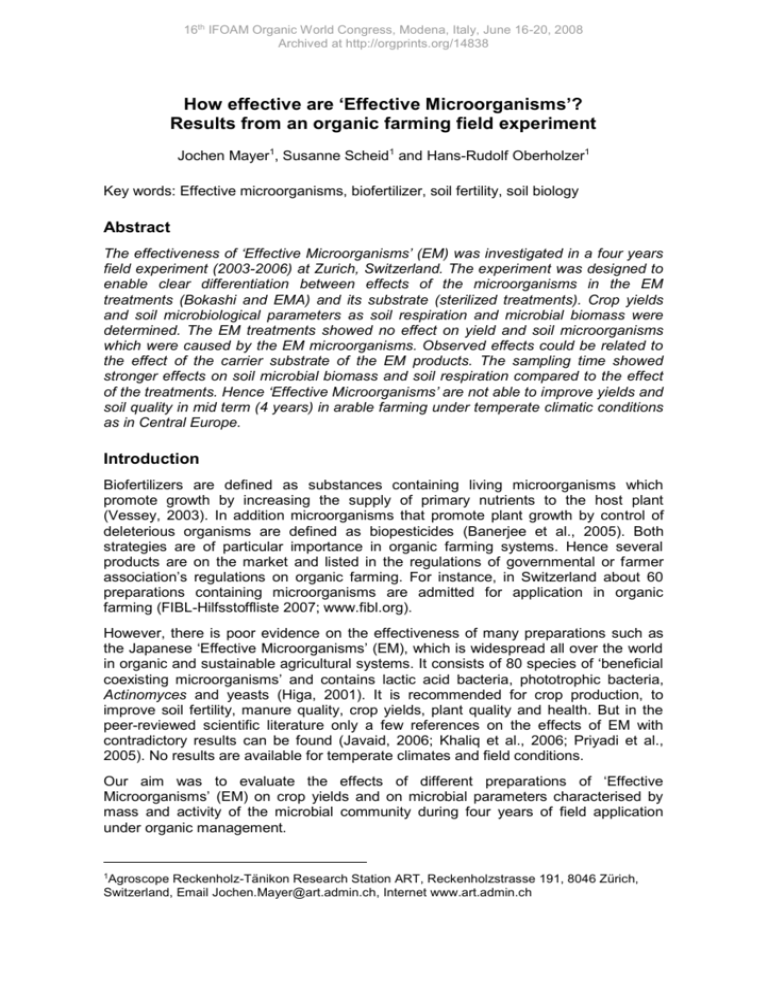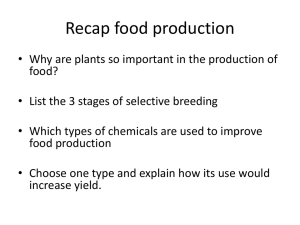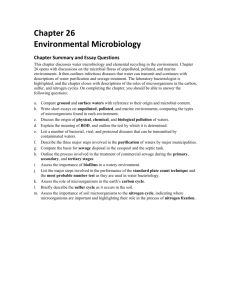How effective are 'Effective Microorganisms'? Results from an
advertisement

16th IFOAM Organic World Congress, Modena, Italy, June 16-20, 2008 Archived at http://orgprints.org/14838 How effective are ‘Effective Microorganisms’? Results from an organic farming field experiment Jochen Mayer1, Susanne Scheid1 and Hans-Rudolf Oberholzer1 Key words: Effective microorganisms, biofertilizer, soil fertility, soil biology Abstract The effectiveness of ‘Effective Microorganisms’ (EM) was investigated in a four years field experiment (2003-2006) at Zurich, Switzerland. The experiment was designed to enable clear differentiation between effects of the microorganisms in the EM treatments (Bokashi and EMA) and its substrate (sterilized treatments). Crop yields and soil microbiological parameters as soil respiration and microbial biomass were determined. The EM treatments showed no effect on yield and soil microorganisms which were caused by the EM microorganisms. Observed effects could be related to the effect of the carrier substrate of the EM products. The sampling time showed stronger effects on soil microbial biomass and soil respiration compared to the effect of the treatments. Hence ‘Effective Microorganisms’ are not able to improve yields and soil quality in mid term (4 years) in arable farming under temperate climatic conditions as in Central Europe. Introduction Biofertilizers are defined as substances containing living microorganisms which promote growth by increasing the supply of primary nutrients to the host plant (Vessey, 2003). In addition microorganisms that promote plant growth by control of deleterious organisms are defined as biopesticides (Banerjee et al., 2005). Both strategies are of particular importance in organic farming systems. Hence several products are on the market and listed in the regulations of governmental or farmer association’s regulations on organic farming. For instance, in Switzerland about 60 preparations containing microorganisms are admitted for application in organic farming (FIBL-Hilfsstoffliste 2007; www.fibl.org). However, there is poor evidence on the effectiveness of many preparations such as the Japanese ‘Effective Microorganisms’ (EM), which is widespread all over the world in organic and sustainable agricultural systems. It consists of 80 species of ‘beneficial coexisting microorganisms’ and contains lactic acid bacteria, phototrophic bacteria, Actinomyces and yeasts (Higa, 2001). It is recommended for crop production, to improve soil fertility, manure quality, crop yields, plant quality and health. But in the peer-reviewed scientific literature only a few references on the effects of EM with contradictory results can be found (Javaid, 2006; Khaliq et al., 2006; Priyadi et al., 2005). No results are available for temperate climates and field conditions. Our aim was to evaluate the effects of different preparations of ‘Effective Microorganisms’ (EM) on crop yields and on microbial parameters characterised by mass and activity of the microbial community during four years of field application under organic management. 1 Agroscope Reckenholz-Tänikon Research Station ART, Reckenholzstrasse 191, 8046 Zürich, Switzerland, Email Jochen.Mayer@art.admin.ch, Internet www.art.admin.ch 16th IFOAM Organic World Congress, Modena, Italy, June 16-20, 2008 Archived at http://orgprints.org/14838 Materials and methods A field experiment (randomised block design, 4 replicates) was established at Agroscope Reckenholz-Tänikon Research Station ART in Zurich, Switzerland, from 2003 to 2006 on an organically managed field (medium eutric Regosol, mean temperature 8.5°C, mean rainfall 1042 mm). Treatments of the EM preparations EMA as spraying agent and Bokashi as organic fertilizer were applied (Table 1). Treatments without EM and parallel treatments with autoclaved EM preparations, to separate the effect of the microorganisms from its substrate, served as controls (Table 1). Bokashi and the first EMA spraying were applied at sowing. The further EMA sprayings were spread during the vegetation period until flowering and after the cutting of lucerne. Tab. 1: Treatments of the EM field experiment No Treatment1 EMA spraying2 EM-Bokashi4 Manure4 1 control 3 x H2O - - Potatoes were cropped in 2003 followed by winter barley in 2004, 2 sp 3 x3 lucerne in 2005 and 3 sp au 3 x au3 winter wheat in 2006. 4 sp+bok 3x 2.9 t ha-1 Crop yields, soil microbial biomass C by 5 sp+bok au 3 x au 2.9 t ha-1 au chloroform fumigation 6 sp+bok+m 3x 2.9 t ha-1 10 t ha-1 extraction (CFE) and soil -1 -1 7 sp+bok+m au 3 x au 2.9 t ha au 10 t ha basal respiration were 1 bok = Bokashi; sp = spraying; m = manure; au = autoclaved determined. Soil samples 2 -1 110 litre EMA ha per application (0 – 20cm) were taken in 3 in 2003 additional pickling of potato seed stock with EMA March 2005, in October 4 fresh matter basis 2005 immediately before (autumn 05 I) and after sowing of winter wheat (autumn 05 II) and in March 2006. Results Crop yields Potatoes showed no significant differences in yield in 2003. From 2004 to 2006 yields of the EMA spraying treatments 2 and 3 (sp, sp au; table 2) showed no differences to the untreated control. However yields differed considerably in treatments with additional Bokashi application. Winter barley yields in 2004 were increased compared to the control between 23% in treatment 6 (sp+bok+m) to 36% in treatment 4 (sp+bok), but the comparatively high differences were not significant. Differences of winter wheat yield to the control in 2006 ranged between 13% in treatment 6 (sp+bok+m) and 23% in treatment 7 (sp+bok+m au). But significant differences were only found between the control, treatment 3 (sp au) and treatment 7 (sp+bok+ m au) (Table 2). The additional application of manure to spraying combined with Bokashi application did not cause any distinct yield effects. The lucerne yields in 2005 showed a similar pattern but differences between the treatments were small. The statistical evaluation, comparing the factor living EM with sterilised EM (treatment 2, 4, 6 vs. 3, 5, 7) resulted in no significant difference. Soil respiration and microbial biomass Soil respiration (SR) did not differentiate between the untreated control and the EMA spraying treatments 2 and 3 (sp, sp au; fig. 1A) on each sampling date. But SR increased in the treatments with additional Bokashi application (Treatment 1, 2, 3 vs. 16th IFOAM Organic World Congress, Modena, Italy, June 16-20, 2008 Archived at http://orgprints.org/14838 4, 5, 6, 7). These differences were not consistent throughout the treatments with Bokashi application and during sampling dates. In autumn 05 II treatments 4, 5 and 7 differed significantly from 1 – 3, but not treatment 6. In spring 06 treatment 4, 6, and 7 differed significantly from 1 – 3, but not treatment 5 (Fig 1A). In analogy to crop yields the comparison of living EM with sterilised EM (treatment 2, 4, 6 vs. 3, 5, 7) resulted in no significant difference. Tab. 2: Yields of main crops from 2003 – 2006. Differing letters in columns show significant differences of means (Tukey, p<0.05) No 1 2 3 Treatment control sp sp au Potatoes 2003 Winter barley 2004 Lucerne 20051 Winter wheat 2006 (t FM ha-1) (t FM ha-1) (t DM ha-1) (t FM ha-1) 27.4 a 33.3 a 30.6 a a 2.95 a 3.30 a 2.88 a 4.00 a 14.0 a 2.97 a 14.6 a 3.16 ab 13.8 a 2.95 a 14.5 a 3.53 ab 4 sp+bok 27.0 5 sp+bok au 26.9 a 3.80 a 14.4 a 3.48 ab 6 sp+bok+m 30.3 a 3.63 a 15.1 a 3.36 ab 7 sp+bok+m au 29.0 a 3.75 a 14.7 a 3.64 b 1 Summ of 4 cuts The results of soil microbial biomass C were similar to soil respiration. No significant differences were found between the untreated control and treatment 2 and 3. Significant differences were only found between treatment 1 – 3 and 4 – 7 (Fig 1B). The differences were not consistent throughout the treatments with Bokashi application and during sampling dates. Treatments with living EM were not significantly different from the sterilised treatments (treatment 2, 4, 6 vs. 3, 5, 7). Distinct effects of sampling date were observed. Soil respiration and microbial C differed significantly at spring 05, autumn 05 I and autumn 05 II, but not between autumn 05 II and spring 06 (SR p< 0.000; CFE-C p<0.000). Discussion and conclusions Significant differences of EM treatments to the untreated control were only found between treatments with Bokashi application. EMA spraying alone had no effects on either crop yields or soil microbial parameters. Differences can be explained by the considerable amounts of nutrients of 401 kg N, 16 kg P, 33 kg K and 7 kg Mg ha -1 a-1 which were applied with Bokashi. However, the effects of additional manure application were small. No differences were found between EM treatments and the sterilized EM control treatments. Hence the observed effects could solely be related to the carrier substrate of Bokashi. The microorganisms in the EM preparations caused no effects. Overall the effects on soil microbial parameters were small and the sampling date showed greater differences as the treatments and fertilization effects. Our results are in good agreement with the findings of Priyadi et al. (2005) who found no effects of EM application on corn yields in Indonesia. Khaliq et al. (2006) found no EM effects by applying EM alone on seed cotton, but concluded an improved fertilizer effect combining NPK and organic matter applications with EM. However, these studies did not use sterilised treatments and thus the interpretation whether substrate or microbial effects are responsible for the observations is difficult. 16th IFOAM Organic World Congress, Modena, Italy, June 16-20, 2008 Archived at http://orgprints.org/14838 A 0.8 a a a a a a a ab ab ab b a ab ab a ab a b b ab b ab ab b ac abc ac c 0.6 0.5 -1 -1 CO2-C (µg g soil h ) 0.7 0.4 0.3 0.2 0.1 0.0 Spring 05 B Autumn 05 I Autumn 05 II Spring 06 600 ab ab a ab ab ab b ab ab b a ab ab a ab ab b a ab ab a ab ab b a ab a a 400 -1 Cmic (µg g soil) 500 300 200 100 0 Spring 05 1 control 2 sp Autumn 05 I 3 sp au 4 sp+bok Autumn 05 II 5 sp+bok au 6 sp+bok+m Spring 06 7 sp+bok+m au We conclude from our results that the 4 years application of ‘Effective Microorganisms’ in the temperate climate of Central Europe under organic farming management caused no significant effects on crop yields and soil microbial parameters. The observed effects could solely be related to the nutrient inputs of the carrier substrate Bokashi, but the microorganisms itself had no effects. Effects of sampling time exceeded effects of treatments. Figue 1: Soil respiration (A) and microbial biomass C (B) of soils at differing sampling dates. Autumn 05 I = before EM application, Autumn 05 II = after EM application; (Tukey, p<0.05) References Banerjee, M.R., L. Yesmin and J.K. Vessey (2005): Plant-growth-promoting rhizobacteria as biofertilizers and biopesticides. Handbook of microbial biofertilizers. Higa, T. (2001): Effective Microorganisms in the context of Kyusei Nature Farming: a technology for the future. Sixth International Conference on Kyusei Nature Farming Proceedings of the conference on greater productivity and a cleaner environment through Kyusei Nature Farming, University of Pretoria, Pretoria, South Africa, 28 31 October, 1999. Javaid, A. (2006): Foliar application of effective microorganisms on pea as an alternative fertilizer. Agronomy For Sustainable Development 26:257-262. Khaliq, A., M.K. Abbasi, and T. Hussain (2006): Effects of integrated use of organic and inorganic nutrient sources with effective microorganisms (EM) on seed cotton yield in Pakistan. Bioresource Technology 97:967-972. Priyadi, K., H. Abdul, T.H. Siagian, C. Nisa, A. Azizah, N. Raihani, and K. Inubushi (2005): Effect of soil type, applications of chicken manure and effective microorganisms on corn yield and microbial properties of acidic wetland soils in Indonesia. Soil Science and Plant Nutrition 51:689-691. Vessey, J.K. (2003): Plant growth promoting rhizobacteria as biofertilizers. Plant and Soil 255:571586.






